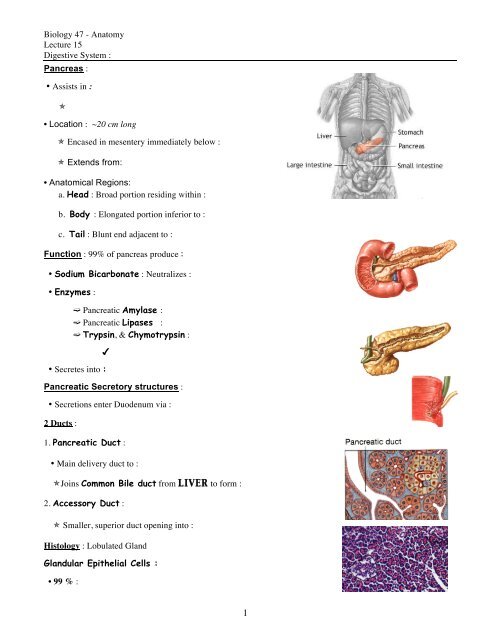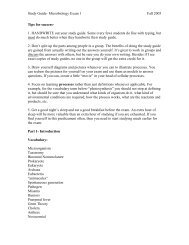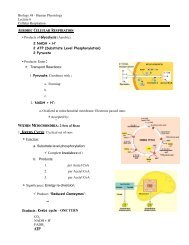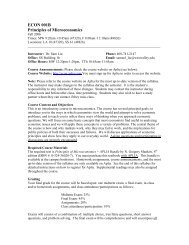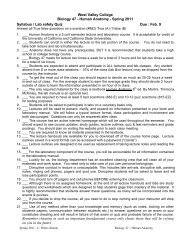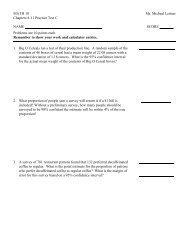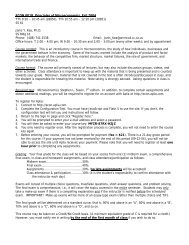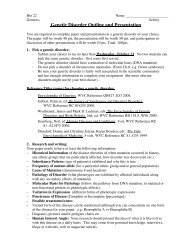Biology 47 - Anatomy Lecture 15 Digestive System : Pancreas ...
Biology 47 - Anatomy Lecture 15 Digestive System : Pancreas ...
Biology 47 - Anatomy Lecture 15 Digestive System : Pancreas ...
You also want an ePaper? Increase the reach of your titles
YUMPU automatically turns print PDFs into web optimized ePapers that Google loves.
<strong>Biology</strong> <strong>47</strong> - <strong>Anatomy</strong><br />
<strong>Lecture</strong> <strong>15</strong><br />
<strong>Digestive</strong> <strong>System</strong> :<br />
<strong>Pancreas</strong> :<br />
• Assists in :<br />
<br />
• Location : ~20 cm long<br />
Encased in mesentery immediately below :<br />
Extends from:<br />
• Anatomical Regions:<br />
a. Head : Broad portion residing within :<br />
b. Body : Elongated portion inferior to :<br />
c. Tail : Blunt end adjacent to :<br />
Function : 99% of pancreas produce :<br />
• Sodium Bicarbonate : Neutralizes :<br />
• Enzymes :<br />
Pancreatic Amylase :<br />
Pancreatic Lipases :<br />
Trypsin, & Chymotrypsin :<br />
<br />
• Secretes into :<br />
Pancreatic Secretory structures :<br />
• Secretions enter Duodenum via :<br />
2 Ducts :<br />
1. Pancreatic Duct :<br />
• Main delivery duct to :<br />
Joins Common Bile duct from LIVER to form :<br />
2. Accessory Duct :<br />
Smaller, superior duct opening into :<br />
Histology : Lobulated Gland<br />
Glandular Epithelial Cells :<br />
• 99 % :<br />
1
Acinar Cells : Secrete :<br />
• 1 % :<br />
Islets of Langerhans: Groups of :<br />
Beta Cells (60%): Insulin<br />
Alpha Cells (25%): Glucagon<br />
Delta Cells (<strong>15</strong>%): Somatostatin<br />
Insulin & Glucagon regulate :<br />
Liver : “Hepat” = Liver<br />
Functions :<br />
Largest :<br />
A. Metabolic Regulation :<br />
• Regulates :<br />
ALL BLOOD leaving <strong>Digestive</strong> Tract travels directly to :<br />
<br />
• Liver Cells : Hepatocytes<br />
1. Monitor & adjust :<br />
2. Remove & store :<br />
3. Detoxify blood<br />
B. Hematological Functions : Heme = “blood”<br />
• Regulates Blood Composition<br />
1. Kupffer Cells :<br />
Remove old or damaged :<br />
2. Produce :<br />
C. Bile Synthesis & Secretion :<br />
• Bile : Breakdown product of :<br />
Function :<br />
1. Neutralize Acid :<br />
2. Emulsify Lipids ; Break lipids into :<br />
Storage :<br />
<strong>Anatomy</strong> : Large lobed structure (4)<br />
• Lobes :<br />
Large :<br />
Small : Caudate & Quadrate lobe<br />
2
Blood Circulation: High rate of Profusion<br />
Input: 2 Blood Sources:<br />
a. Hepatic Artery: Blood delivered from :<br />
25% of total :<br />
<br />
b. Hepatic Portal Vein: Blood delivered from the:<br />
Nutrient Rich: Oxygen POOR blood from:<br />
Blood to be PROCESSED by LIVER<br />
Output: 1 Blood Outlet:<br />
Histology :<br />
Hepatocytes :<br />
a. Hepatic Vein: Blood returned to :<br />
Processed blood carried to heart to be :<br />
• Hepatocytes arranged into Columns around a large :<br />
Result :<br />
“Spokes on a wheel”<br />
Lobules: Functional hexangonal arrangement of :<br />
(100,000 Lobules/ Liver)<br />
Sinusoids : Extensions of blood vessels between :<br />
Carries blood to be processed past :<br />
(site of Kupffer cells)<br />
Movement of Fluid through Liver :<br />
• Blood enters via :<br />
a.<br />
b.<br />
• BOTH vessels branch into smaller vessels<br />
Supplying EACH :<br />
• Blood enters lobules at the :<br />
Blood travels down Sinusoids :<br />
Regulating:<br />
<br />
3
“Processed Blood”; Drains into :<br />
• ALL Central veins unite to form the :<br />
Delivers “processed” blood to the :<br />
• Bile Canaliculi :<br />
Canaliculi =<br />
Narrow Intercellular Channels draining :<br />
<br />
Bile flows away from Central Vein : Toward the :<br />
Collected by :<br />
Hepatic Triad : “Portal Triad”<br />
• Arrangement of vessels at lobule periphery<br />
Branch of :<br />
Bile Drainage :<br />
Hepatic Portal Vein<br />
Hepatic Artery<br />
Bile Duct<br />
• Rt. Hepatic Ducts : Collects bile from bile ducts on :<br />
• Lft. Hepatic Ducts : Collects bile from bile ducts on :<br />
• Common Hepatic Duct : Union of :<br />
4
• Cystic Duct : Duct to/from:<br />
• Common Bile Duct : Union of :<br />
Drains into :<br />
<br />
Entrance of Common Bile Duct & Pancreatic Duct into :<br />
Clinical Application : Liver Cirrhosis<br />
• Scarring of liver: Formation of fibrous (scar) tissue associated with destruction of normal<br />
liver architecture :<br />
Study Questions :<br />
1. What is the digestive functional significance of the pancreas? What composes the pancreatic juice? How is<br />
the pancreatic juice released into the duodenum?<br />
2. What is the functional significance of the Islets of Langerhans?<br />
3. What are the 3 primary functions of the Liver?<br />
4. Where does blood leaving the intestine travel? What is the functional significance of bile ? From what is bile<br />
derived? What is the function of Kupffer cells<br />
5. Describe the blood supply to the liver. What is the difference between the hepatic portal vein, the hepatic<br />
artery and the hepatic vein? What degree of oxygenated blood is carried within each vessel ?<br />
6. Describe the structure of the liver lobules : what cells comprise the lobule, how they are arranged, & the<br />
sinusoid arrangement.<br />
7. What is the function of the sinusoids and bile canaliculi? In which direction does fluid flow in each passage<br />
way (toward the periphery of the lobule or toward the center)?<br />
8. How is “processed blood” removed from the liver? To where does this blood travel?<br />
9. How is “Unprocessed blood” delivered to the liver? What cells process this blood?<br />
10. How are hepatocytes supplied with oxygen to maintain their active metabolism?<br />
11. Describe the movement of bile from the hepatocytes to the hepatic ducts.<br />
12. How is bile moved from the hepatic ducts to the gall bladder ? How is bile released into the duodenum from<br />
the gall bladder?<br />
5


